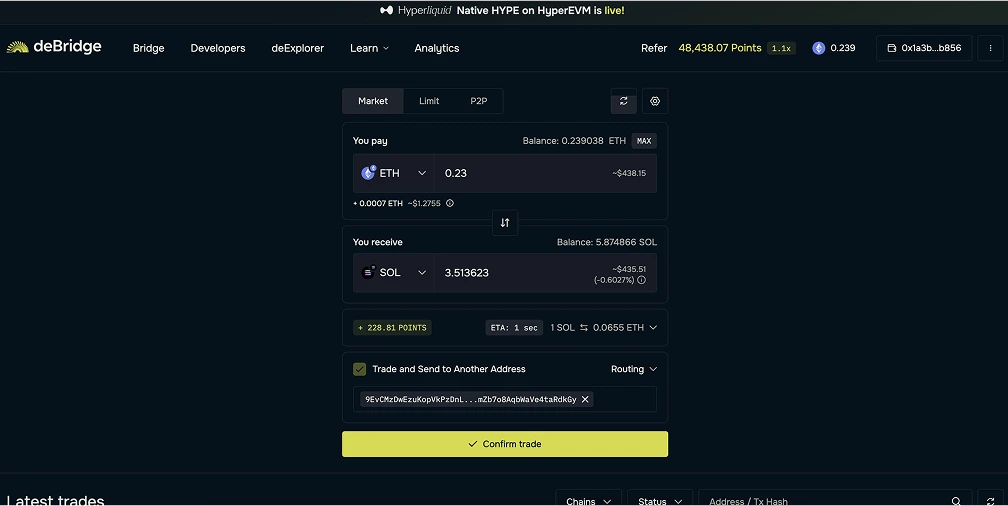

摘要: 加密桥接器实现了跨区块链的资产转移,但安全风险仍然很高,桥接器黑客攻击造成的损失超过 28 亿美元。选择合适的桥接器需要仔细考虑安全性、成本、交易速度以及与 EVM 和非 EVM 链的兼容性。
我们对最安全、最具成本效益的加密桥接器进行了审查和排名,包括以太坊、第 2 层卷积、比特币第 2 层、Cosmos 和 Solana 等非 EVM 网络:
.svg)
deBridge 是整体性能最好的桥接器,提供即时(约 2 秒)转账、超低费用、强大的去中心化验证以及无与伦比的可靠性,转账金额超过 90 亿美元,并且没有漏洞。
以太坊、第 2 层、索拉纳、声波等
WETH、USDC、USDT、SOL 及其他
哈尔伯恩、佐京和免疫菲
跨链交换的最佳加密桥接器
加密桥接器可实现跨区块链的高效资产转移,但选择最佳解决方案取决于速度、费用、安全性和网络兼容性等因素。
网桥架构差异很大,从传统的锁定、薄荷和烧毁模式到创新的基于意图的协议,每种架构都有不同的权衡。
下表比较了我们的 7 大加密桥接器,包括领先的 EVM 第一层和第二层平台,以及著名的非 EVM 网络(如 Solana、Cosmos 和 Sui),以帮助您为安全的跨链交易选择合适的桥接器。
1. deBridge - 最佳综合加密桥接器
deBridge是加密货币首屈一指的跨链协议,利用去中心化验证器安全地连接资产,而无需依赖锁定的流动性池。其创新的 "意向 "模型可促进即时跨链转账、数据信息传递、NFT 和治理行动,从而增强构建者和交易者的能力。
deBridge 的结算金额超过 99.6 亿美元,中位交易时间仅为 1.96 秒,具有无与伦比的速度和可靠性。其零TVL流动性网络可确保超低点差(4个基点),并保护用户免受常见桥接漏洞的侵害。
deBridge 深受顶级 DeFi 平台的信赖,在超过 26 次安全审计的支持下,保持着 100% 正常运行时间的完美记录。其强大的设计使其成为跨链互操作性最安全、最高效的选择。
平台亮点:
- 支持的链:以太坊、Arbitrum、Avalanche、Solana、BNB Chain、Base、Fantom、Optimism、Polygon、Gnosis、Linea、Metis、Sonic、Hyperliquid、Berachain、Story Protocol 等。
- 支持的代币:ETH、USDC、USDT、WBTC、DAI 和 1,000 多种代币。
- 平台费用: 0.001 ETH 统一费用。

2.Rhino.Fi - 流行桥接器和 DeFi 聚合器
Rhino.fi是一款 DeFi 聚合器,专为跨多个区块链进行快速、经济高效的代币桥接而设计。利用 StarkEx 的 Layer-2 技术,Rhino.fi 通过 zk-proofs 对链外交易进行批处理,确保在以太坊、Layer 2 和 Solana、Tron 和 ZetaChain 等非 EVM 链上实现亚秒级存款、即时取款和无摩擦交易。
自 2020 年以来,Rhino.fi 已促成了超过 44.5 亿美元的安全转账,通过抵押流动性前哨站提供了无与伦比的 60 秒中位结算时间。用户无需持有原生天然气代币,也无需冒锁定流动性的风险,即可从自我托管桥接中获益。
定期的 PeckShield 审计和零托管风险确保了安全性。其直观的抵押模式受到 70 多万用户的信赖,可提供最快、最安全的多链桥接。
平台亮点:
- 支持的链:以太坊、Arbitrum、ZetaChain、Avalanche、Solana、BNB Chain、Base、Optimism、Polygon、Linea、Mantle、zkSync、TON、Tron、Blast、Sonic、Unichain、Scroll、Manta Pacific Berachain、Story Protocol 等。
- 支持的代币:超过 500 种代币,包括 ETH、USDC、USDT、WBTC 和 DAI。
- 平台费用: 0.12% 互换费

3.跨协议 - 最佳第 2 层网桥
Across Protocol是速度最快、成本最低的第 2 层网桥,采用创新的 "意图 "模式。与依赖锁定流动性的传统桥接器不同,Across 利用有竞争力的中继器即时执行用户订单,从而实现无摩擦的跨链传输。
Across 已完成超过 200 亿美元的转账和 1400 万笔交易,平均结算时间不到 1 分钟,收费也是业内最低的(每 ETH 桥接不到 1 美元)。其模块化设计具有竞争力的中继器和安全托管结算层,可提高资本效率,消除滑点和传统桥接风险。
Across Protocol 基于意图的方法为第二层互操作性树立了新的基准,受到 Uniswap、MetaMask、Balancer 和 OKX 等顶级 DeFi 应用程序的信赖。开发人员可从简单的 REST API 集成中获益,使用户能够毫不费力地跨 L2 生态系统进行交互,而不会感到复杂。
平台亮点:
- 支持的链:Optimism、Polygon、Arbitrum、Base、zkSync、Linea、Scroll、Blast、Mode、以太坊主网、Hyperliquid 等。
- 支持代币:WETH、DAI、USDT、USDC、BAL、ACX 和 50 多种代币。
- 平台费用: 0.1% 互换费

4.Rango Exchange - 实现大多数连锁集成的最佳桥梁
Rango Exchange是领先的多链 DEX 和桥接聚合器,可在 70 多个区块链上实现高效的代币交换。Rango 利用 100 多个 DEX、24 个桥接器和去中心化消息传递协议(GMP、LayerZero、IBC),从一个接口识别最快、最安全和成本最低的路线。
Rango 为 EVM 链、Cosmos、Solana、比特币、StarkNet 等提供深度流动性,在 380 万次掉期交易中实现了超过 37.4 亿美元的交易额。其先进的路由引擎可动态评估数千条路径,消除滑点,最大限度地提高交易效率。
Rango 受到包括 Trust Wallet、Exodus 和 Binance Web3 Wallet 在内的顶级钱包的信任,通过多重审核保持严格的安全标准,零漏洞。其直观、非托管设计可确保无缝连接整个加密生态系统。
平台亮点:
- 支持的链:以太坊、Arbitrum、Base、Stargaze、Linea、Scroll、Avalanche、Solana、Bitcoin、Cosmos、Osmosis、StarkNet、Tron、TON、Polygon zkEVM、Mode、Blast、Berachain、Zora、Doge、Neutron、Kava、OKTC Chain、Injective 等 50 多种链。
- 支持的代币:1000 多种代币,包括 ETH、USDC、USDT、WBTC 和 DAI。
- 平台费用: 0.1% 互换费

5.Orbiter Finance - 比特币 L2 的最佳桥梁
Orbiter Finance是一个去中心化的跨卷积桥接器,针对以太坊、ETH L2s(如 Base 和 Fraxtal)和比特币原生资产跨第二层网络进行了优化。其轻量级、无信任模式通过直接 EOA 交易和动态费用避免了常见的桥接漏洞,大大降低了转账成本。
Orbiter 专注于以比特币为核心的 L2,如 BOB、Bitlayer、BSquared、BEVM 和 Merlin Chain,可在 10-20 秒内完成快速交易结算。其独特的识别码系统可在链之间精确分配资产,确保简单、准确。
Orbiter 的仲裁机制允许用户使用零知识证明来质疑无效或延迟的转账,从而加强了以太坊第 2 层框架的安全性。这种方法为比特币第 2 层生态系统提供了可靠、低风险的理想桥接。
平台亮点:
- 支持的链:以太坊、Bitlayer、Fraxtal、BSquared、BEVM、zkLink、Merlin Chain、zkSync Era、StarkNet、Arbitrum、Optimism、Scroll、Base、Linea、Polygon zkEVM、Solana、Sui、TON、Mantle、Zora、opBNB、ImmutableX 等 50 多种链。
- 支持的代币:以太坊、比特币原生资产、主要稳定币和领先的蓝筹代币。
- 平台费用: 0.03% 互换费

6.跳转协议--宇宙链的最佳桥梁
Skip 协议是 Cosmos 链的最佳互操作性协议,它通过基于意图的 Skip Go 应用程序接口实现令牌交换、跨链传输和集成应用程序工作流。与简单的转账不同,Skip 可在 Cosmos、以太坊和 L2 网络之间组成多跳路由。
利用去中心化报文标准(IBC、Hyperlane、Axelar),Skip 支持 Osmosis、Neutron、Celestia、dydx、Noble 和 50 多个 Cosmos 原生链。开发人员使用 Skip 的统一 API 构建直观的跨链交互,确保高效的路径、快速的执行和有竞争力的费用(平均每笔掉期只有几个基点)。
Skip 集成到 Keplr 和 Leap 等领先钱包中,在 Cosmos 共识的保障下提供近乎即时的跨链转账。其意图驱动型架构简化了复杂性,为用户提供精确的结果、优化的成本以及跨 Cosmos 生态系统的无摩擦桥接。
平台亮点:
- 支持的链:Cosmos Hub、Osmosis、Neutron、Noble、Celestia、dydx、Keplr、Leap、Stargaze、Secret、Oraichain、OKTC Chain、Kava、Ethereum、Arbitrum、Optimism、Polygon、Base、zkSync、Merlin、Injective、Sei 等 50 多种链。
- 支持的代币:ATOM、OSMO、USDC、USDT、ETH 和主要 Cosmos 生态系统代币。
- 平台费用: 视路线而定,每次掉期 0.02% - 0.09%。

7.门户桥接器 - 受非 EVM 链的欢迎
Portal Bridge 由 Wormhole 提供技术支持,是连接 Solana、Aptos、Sui、Algorand 和 Injective 等流行非 EVM 区块链与以太坊、BNB Chain、Base 和 Arbitrum 等主要 EVM 网络的领先跨链解决方案。锁定在原链上的资产在目标链上被铸造为封装代币,支持跨生态系统的深度流动性。
守护者验证器组成的可信网络可确保转账安全,实现快速、低成本交易(每次转账约 0.0001 美元)。守护者独立验证交易,确保可靠的跨链桥接。
不过,用户应该注意,Portal 在 2022 年 2 月遭受了一次重大黑客攻击,损失了大约 3.2 亿美元的包装 ETH。此后,通过 Open Zeppelin 等一级公司的全面审计,安全性得到了大幅提高。
平台亮点:
- 支持的链:Solana、Aptos、Sui、Algorand、Injective、Ethereum、BNB Chain、Base、Arbitrum、Avalanche、Polygon、Optimism、Fantom、Celo、Near、Oasis、Moonbeam、Klaytn、Karura、Aurora 等。
- 支持的代币:ETH、SOL、USDC、USDT、WBTC、DAI、NFTs(ERC721、SPL)以及数百种流行代币。
- 平台费用:0.1% 互换费

什么是加密桥?
加密桥连接着区块链生态系统,使资产、数据和指令能够在网络间无缝流动。它们在促进流动性、可扩展性和有效的跨链互动方面发挥着至关重要的作用。
资产桥梁
资产桥接器使用锁币或烧币等方法在链间转移加密货币,确保资产在区块链之间保持一致。这些桥梁对于保持流动性和实现不同加密生态系统之间的互操作性至关重要。
最受欢迎的例子包括连接 Binance 智能链与其他网络的 BinanceBridge,以及可在以太坊、Solana 和其他著名区块链之间进行资产转移的Wormhole。
基于意图的信息传递桥梁
基于意图的桥接允许用户指定链外操作("意图"),然后在目的地区块链上执行。通过强调意图而非即时传输,这些协议可以减少链上负载、提高交易速度并增强可扩展性。
领先的基于意图的解决方案包括Across Protocol(针对以太坊第 2 层网络之间的快速资产转移进行了优化)和deBridge(提供先进的意图驱动跨链合约互动和治理)。

数据桥
数据桥专注于在区块链网络之间传输信息,为去中心化应用程序(dApps)的实时通信提供动力。它们对于跨链治理、甲骨文更新和不同链之间的状态同步至关重要。
著名的例子包括提供安全跨链数据交换和去中心化甲骨文服务的Chainlink CCIP,以及高效跨链消息和数据传输的领先协议LayerZero。

卷筒专用桥梁
以太坊第 2 层卷筒之间或卷筒与以太坊主网之间的转账由卷筒专用桥接器处理。这些桥接器专为满足 rollups 独特的可扩展性要求而设计,可促进快速、经济高效的交易。
主要的例子包括Orbiter Finance(提供 Optimism 和 Arbitrum 等卷标之间的简化转移)和Hop Protocol(专门在以太坊主网和第二层解决方案之间快速转移资产)。

如何连接加密资产:以太坊到基础货币示例
下面是一个快速的四步演练,说明在链之间桥接加密资产是多么简单。在本示例中,我们使用的是 deBridge,这是一个以即时结算和顶级安全性著称的可信跨链协议。
使用 deBridge 逐步将以太坊转移到 Base:
- 连接钱包进入 deBridge 应用程序,连接钱包(推荐使用 MetaMask)。
- 选择网络和资产: 将以太坊设置为源网络,选择 Base 作为目标,然后选择要桥接的资产(ETH、USDC 等)。
- 确认转账: 输入转账金额、批准交易并通过钱包确认。
- 在基地上接收资产: 确认后,您的代币将迅速出现在基地上,可立即使用。

加密桥安全吗?
跨链桥接是必不可少的,但也存在重大安全风险。截至 2025 年,与桥接相关的黑客攻击造成的损失已超过 28 亿美元,占所有 Web3 漏洞的近 40%。常见漏洞包括私钥泄露、智能合约审核不严以及升级流程不安全。
著名事件包括
- 浪人桥破解版 (2022 年 3 月):攻击者破解了九个验证密钥中的五个,窃取了 6.25 亿美元。
- 和谐桥漏洞 (2022 年 6 月):两个被泄露的私钥导致 1 亿美元的损失。
- 虫洞桥攻击 (2022 年 2 月):有缺陷的智能合约允许攻击者在没有适当抵押的情况下铸造 120,000 wETH(3.25 亿美元)。
如果小心管理,桥梁是安全的,但认识到这些弱点至关重要。

安全跨链桥接技巧
要安全地连接加密资产,请遵循以下最佳实践:
- 审计和历史记录检查:使用具有全面智能合约审计和积极安全记录的桥梁。
- 分散验证器:优先选择由分散式验证器集支持的网桥,以降低集中化风险。
- 谨慎转账:只有在意外情况下,您能承受损失的金额才可进行过桥。
- 实施费率限制:支持提供内置交易限制的网桥,以限制潜在的损失。
- 避免合同升级:在主动升级或重大合同变更期间不要搭桥资金。
- 硬件钱包:始终使用硬件钱包(如 Ledger)与网桥进行交互,以保护私钥。
- 实时监控:选择具有强大交易跟踪和警报系统的网桥。
在驾驭多链生态系统时,遵循这些提示可大大降低风险。
最后的想法
加密货币桥接仍然支离破碎,每个解决方案都是为特定区块链生态系统量身定制的。这种多样性往往会使桥接过程复杂化,需要根据个人需求谨慎选择。
为了实现全面的、与链无关的覆盖,deBridge 和 Rango Exchange 等平台简化了跨链互动。相比之下,诸如 Orbiter Finance(适用于比特币第二层)或 Skip Protocol(适用于基于宇宙的资产)等专业选项则能提供有针对性的效率。
无论是安全性、交易速度还是成本效益,最佳桥接方案最终都要与您的优先事项相一致。幸运的是,您可以随时回来参考我们的指南,将您的桥接需求与最合适的解决方案相匹配。
常见问题
意图与锁定和烧毁桥梁:区别何在?
锁定和烧毁桥接器通过锁定一条链上的资产,并在另一条链上铸造等价物,依靠流动性池来转移代币。基于意图的桥接器使用链外中继器即时完成交易,消除了流动性锁定,降低了风险,加快了转账速度。
封装代币如何运作,是否安全?
封装代币通过锁定一条链上的资产,并在另一条链上铸造等价代币,从而在加密货币之间架起一座桥梁。这种方法提高了跨链流动性和互操作性。虽然这种方法通常是安全的,但如果资产托管或铸币机制遭到破坏,就会出现漏洞。
加密桥接通常需要多长时间?
加密桥接通常需要几秒到几小时不等,取决于区块链流量、桥接设计、确认速度以及所涉及的特定网络等因素。现代桥接通常能快速结算交易,但老式协议可能会出现延迟。
加密货币桥接能否触发应税事件?
一般来说,在区块链之间桥接加密货币不需要纳税,因为你并没有处置资产。但是,如果桥接涉及代币交换、转换或奖励或激励,则可能引发纳税义务。请务必咨询当地税务指南。

%20(1).webp)
